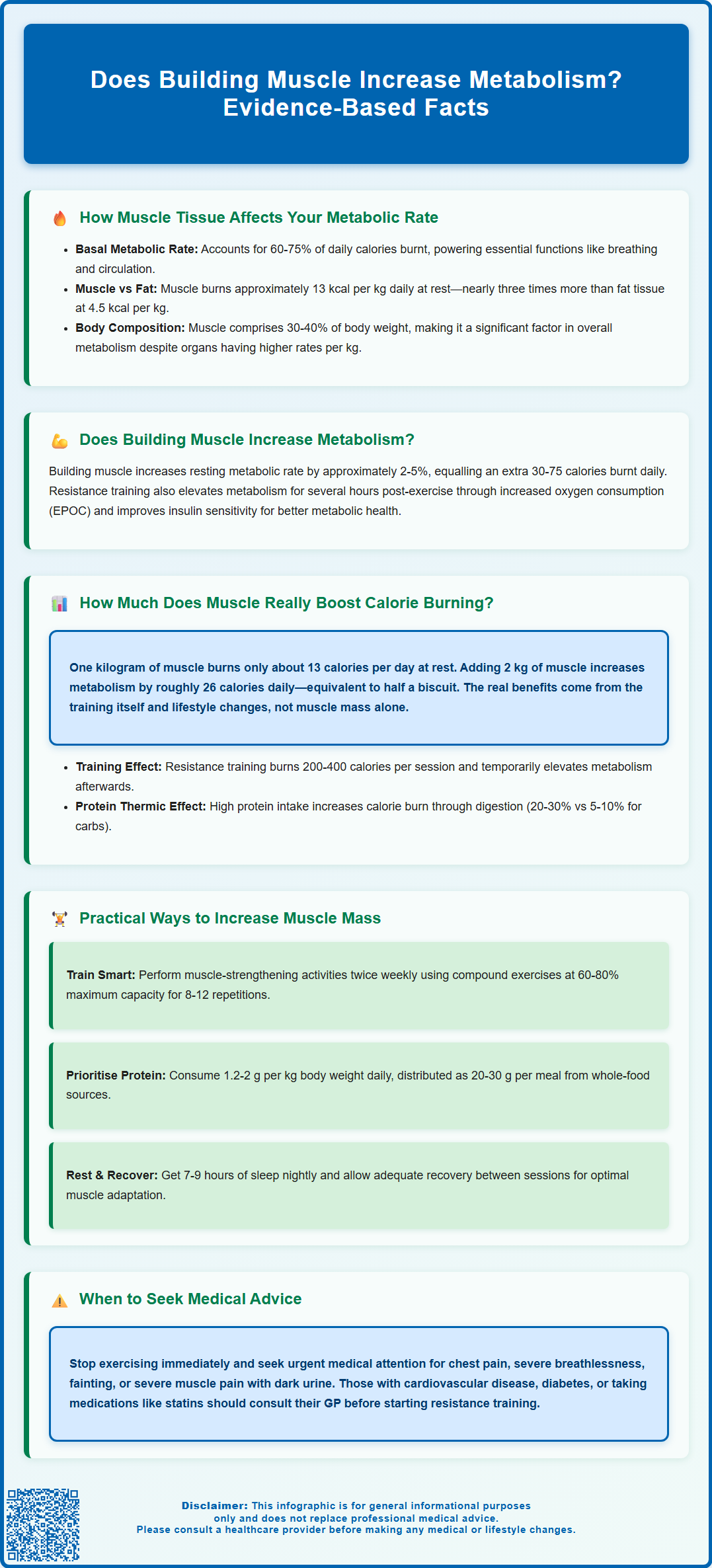Mounjaro®
Dual-agonist support that helps curb appetite, hunger, and cravings to drive substantial, sustained weight loss.
- ~22.5% average body weight loss
- Significant weight reduction
- Improves blood sugar levels
- Clinically proven weight loss

Does building muscle increase metabolism? This question is central to understanding how body composition influences energy expenditure and weight management. Whilst muscle tissue is indeed metabolically active and burns more calories at rest than fat tissue, the magnitude of this effect is often overestimated. Research demonstrates that resistance training can modestly increase resting metabolic rate, typically by 2–5%, alongside broader metabolic benefits including improved insulin sensitivity and enhanced post-exercise calorie burning. This article examines the evidence-based relationship between muscle mass and metabolism, providing realistic expectations and practical guidance for optimising metabolic health through resistance training.
Summary: Building muscle does increase metabolism, typically raising resting metabolic rate by approximately 2–5%, though the effect is modest with each kilogram of muscle burning around 13 kcal per day at rest.
Metabolic rate refers to the total energy expenditure of the body, comprising several components including basal metabolic rate (BMR), the thermic effect of food, and energy expended through physical activity. BMR represents the calories your body requires to maintain essential physiological functions at rest, such as breathing, circulation, cellular repair, and temperature regulation. This accounts for approximately 60–75% of total daily energy expenditure in most individuals.
Muscle tissue is metabolically active, meaning it requires energy to maintain its structure and function even when at rest. Skeletal muscle contains numerous mitochondria—the cellular powerhouses responsible for energy production—and continuously undergoes protein synthesis and breakdown. This metabolic activity means that muscle tissue burns more calories per kilogram than adipose (fat) tissue, which has a lower energy requirement though it does have important endocrine functions.
The key metabolic differences include:
Skeletal muscle burns approximately 13 kcal per kilogram per day at rest
Adipose tissue burns approximately 4.5 kcal per kilogram per day at rest
Muscle tissue requires constant protein turnover and cellular maintenance
Greater muscle mass increases the body's baseline energy requirements
It is important to recognise that whilst muscle tissue is more metabolically active than fat, other organs such as the brain, heart, liver, and kidneys actually have significantly higher metabolic rates per unit mass. For example, the liver and brain may consume 200-240 kcal per kilogram per day. However, because skeletal muscle comprises a substantial proportion of total body mass—typically 30–40% in healthy adults—changes in muscle mass can meaningfully influence overall metabolic rate. Understanding this relationship forms the foundation for evidence-based approaches to weight management and metabolic health optimisation.
The short answer is yes—building muscle does increase metabolism, though the magnitude of this effect warrants careful consideration. When you engage in resistance training and successfully increase lean muscle mass, your resting metabolic rate rises because you have added metabolically active tissue that requires energy for maintenance. This represents a genuine physiological adaptation that can contribute to long-term energy balance and body composition management.
Research demonstrates that resistance training programmes can increase resting metabolic rate, though the effect is often modest. Studies typically show increases of approximately 2-5% following structured training interventions lasting several months. For an individual with a baseline metabolic rate of 1,500 kcal per day, this could translate to an additional 30-75 kcal burned daily at rest. Whilst this may appear modest, over weeks and months, this cumulative effect can contribute to energy expenditure.
The metabolic benefits of muscle building extend beyond resting energy expenditure:
Increased post-exercise oxygen consumption (EPOC): Resistance training elevates metabolism for several hours after exercise completion
Enhanced insulin sensitivity: Greater muscle mass improves glucose uptake and metabolic health markers
Improved body composition: Muscle gain often accompanies fat loss, further optimising metabolic function
Long-term metabolic preservation: Maintaining muscle mass helps counteract age-related metabolic decline
It is worth noting that the metabolic increase from muscle gain occurs gradually and requires consistent training stimulus. The UK Chief Medical Officers recommend adults engage in muscle-strengthening activities on at least two days per week, targeting all major muscle groups. This evidence-based guidance reflects the recognised health benefits of resistance training, including metabolic enhancement, bone density preservation, and functional capacity maintenance throughout the lifespan.

Whilst the principle that muscle increases metabolism is scientifically sound, it is essential to maintain realistic expectations about the magnitude of this effect. The commonly cited figure that one pound of muscle burns 50 calories per day at rest is a significant overestimation. Evidence-based research indicates that one kilogram of muscle tissue burns approximately 13 kcal per day at rest, whilst one kilogram of fat tissue burns approximately 4.5 kcal per day.
To contextualise these figures: if an individual successfully gains 2 kg of muscle mass through a structured resistance training programme—a realistic achievement over several months—this would increase resting metabolic rate by approximately 26 kcal per day. Whilst this represents a genuine metabolic advantage, it equates to roughly the caloric content of half a digestive biscuit. This modest increase underscores why building muscle alone, without attention to overall energy balance and physical activity levels, is unlikely to produce dramatic changes in body weight.
However, the total metabolic impact of resistance training extends beyond resting muscle metabolism:
The energy expended during resistance training sessions themselves (typically 200–400 kcal per hour depending on body weight, intensity and rest periods)
Elevated post-exercise metabolism typically lasting 6-15% of the exercise energy cost, usually returning to baseline within several hours after training
Increased daily movement and activity levels associated with improved fitness
Enhanced thermic effect of feeding due to increased protein intake often accompanying muscle-building programmes (protein has a higher thermic effect of ~20-30% versus ~5-10% for carbohydrates and ~0-3% for fats)
Research in sports medicine emphasises that the combined effects of resistance training—including the exercise itself, metabolic adaptations, and behavioural changes—can meaningfully contribute to energy expenditure and body composition improvements. The key message is that whilst muscle does increase metabolism, the benefits are optimised when resistance training forms part of a comprehensive approach including adequate physical activity, balanced nutrition, and sustainable lifestyle modifications rather than relying solely on increased muscle mass to 'burn off' excess calories.
Building muscle mass requires a structured approach combining progressive resistance training, adequate nutrition, and sufficient recovery. The NHS and UK Chief Medical Officers recommend that adults engage in muscle-strengthening activities involving all major muscle groups at least twice weekly. For those new to resistance training, consulting with a qualified fitness professional or physiotherapist can ensure proper technique and programme design tailored to individual capabilities and health status.
Evidence-based resistance training principles include:
Progressive overload: Gradually increasing weight, repetitions, or training volume over time to stimulate muscle adaptation
Compound exercises: Prioritising multi-joint movements such as squats, deadlifts, rows, and presses that engage multiple muscle groups
Training frequency: Targeting each major muscle group 2–3 times per week with adequate recovery between sessions
Appropriate intensity: Working at 60–80% of one-repetition maximum for 8–12 repetitions to optimise hypertrophy
Consistency: Maintaining regular training over months and years, as muscle adaptations require sustained stimulus
Nutritional support is equally critical for muscle development. The British Dietetic Association advises that most adults engaged in regular resistance training benefit from protein intake of approximately 1.2–1.7 g per kilogram of body weight daily, with higher intakes (up to 2 g/kg/day) potentially beneficial for those with more intensive training regimes. Distributing protein intake across meals, including 20–30 g of high-quality protein per meal, optimises muscle-building responses. Whole-food protein sources such as lean meats, fish, eggs, dairy products, legumes, and soya products should form the foundation of dietary protein intake. People with kidney disease should consult their doctor or a dietitian before significantly increasing protein intake.
Additional considerations for metabolic health optimisation:
Ensure adequate sleep (7–9 hours nightly), as sleep deprivation impairs muscle recovery and metabolic function
Maintain overall physical activity levels, as resistance training should complement rather than replace cardiovascular exercise and daily movement
Consider age-related factors: older adults may require higher protein intakes and modified training approaches to counteract sarcopenia (age-related muscle loss)
Monitor for signs of overtraining, including persistent fatigue, decreased performance, or increased injury susceptibility
Important safety considerations:
Stop exercising and seek urgent medical attention if you experience chest pain, severe breathlessness, or fainting during exercise
Seek prompt medical advice for severe muscle pain or weakness, especially if accompanied by dark urine, which could indicate rhabdomyolysis
Do not stop prescribed medications such as statins or corticosteroids without consulting your doctor, even if you experience muscle symptoms
If you experience muscle problems while taking statins or other medications, discuss this with your GP (suspected side effects can be reported through the MHRA Yellow Card Scheme)
Patients with pre-existing medical conditions—including cardiovascular disease, diabetes, musculoskeletal disorders, or obesity—should consult their GP before commencing a new resistance training programme. When implemented safely and consistently, resistance training represents an evidence-based intervention for enhancing metabolic health, preserving functional capacity, and supporting long-term wellbeing across the lifespan.
One kilogram of muscle tissue burns approximately 13 kcal per day at rest, compared to 4.5 kcal per kilogram for fat tissue. Gaining 2 kg of muscle would increase resting metabolic rate by approximately 26 kcal daily, though total metabolic benefits extend beyond resting expenditure to include exercise energy cost and post-exercise metabolism.
UK Chief Medical Officers recommend adults engage in muscle-strengthening activities at least twice weekly, targeting all major muscle groups. For optimal muscle development, training each major muscle group 2–3 times per week with adequate recovery between sessions is recommended, using progressive overload principles.
The British Dietetic Association advises that adults engaged in regular resistance training benefit from approximately 1.2–1.7 g of protein per kilogram of body weight daily, distributed across meals with 20–30 g of high-quality protein per meal. People with kidney disease should consult their doctor before significantly increasing protein intake.
The health-related content published on this site is based on credible scientific sources and is periodically reviewed to ensure accuracy and relevance. Although we aim to reflect the most current medical knowledge, the material is meant for general education and awareness only.
The information on this site is not a substitute for professional medical advice. For any health concerns, please speak with a qualified medical professional. By using this information, you acknowledge responsibility for any decisions made and understand we are not liable for any consequences that may result.
Lorem ipsum dolor sit amet, consectetur adipiscing elit, sed do eiusmod tempor incididunt ut labore et dolore magna aliqua. Ut enim ad minim veniam, quis nostrud exercitation ullamco laboris nisi ut aliquip ex ea commodo consequat. Duis aute irure dolor in reprehenderit in voluptate velit esse cillum dolore eu fugiat nulla pariatur.
Block quote
Ordered list
Unordered list
Bold text
Emphasis
Superscript
Subscript